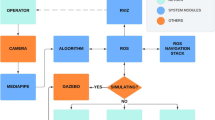Abstract
Extending classical bilateral teleoperation systems to multi-user scenarios allows to broaden their capabilities and extend their applicability to more complex manipulation tasks. In this paper a classical Single-Operator-Single-Robot (SOSR) system is extended to a Multi-Operator-Single-Robot (MOSR) architecture. Two shared-control paradigms which enable visual only or visual and haptic coupling of the two human operators are introduced. A pointing task experiment was conducted to evaluate the two control paradigms and to compare them to a classical SOSR system. Results reveal that operators benefit from the collaborative task execution only if haptic interaction between them is enabled.
Access this chapter
Tax calculation will be finalised at checkout
Purchases are for personal use only
Preview
Unable to display preview. Download preview PDF.
Similar content being viewed by others
References
Baier, H., Buss, M., Freyberger, F., Hoogen, J., Kammermeier, P., Schmidt, G.: Distributed PC-based haptic, visual and acoustic telepresence system-experiments in virtual and remote environments. In: Proceedings of the IEEE Virtual Reality, pp. 118–125 (1999), doi:10.1109/VR.1999.756942
Basdogan, C., Ho, C.H., Srinivasan, M.A., Slater, M.: An experimental study on the role of touch in shared virtual environments. ACM Trans. Comput.-Hum. Interact. 7(4), 443–460 (2000), http://doi.acm.org/10.1145/365058.365082
Chebbi, B., Lazaroff, D., Bogsany, F., Liu, P., Ni, L., Rossi, M.: Design and implementation of a collaborative virtual haptic surgical training system. In: IEEE International Conference on Mechatronics and Automation, vol. 1, pp. 315–320 (2005)
Esen, H.: Training in virtual environments via a hybrid dynamic trainer model. Ph.D. thesis, Technische Universität München (2007)
Glynn, S.J., Fekieta, R., Henning, R.A.: Use of force-feedback joysticks to promote teamwork in virtual teleoperation. In: Proceedings of the Human Factors and Ergonomic Society 45th Annual Meeting (2001)
Groten, R., Feth, D., Klatzky, R., Peer, A., Buss, M.: Efficiency analysis in a collaborative task with reciprocal haptic feedback. In: The 2009 IEEE/RSJ International Conference on Intelligent Robots and Systems (2009)
Hashtrudi-Zaad, K., Salcudean, S.E.: Analysis of control architectures for teleoperation systems with impedance/admittance master and slave manipulators. The International Journal of Robotics Research 20, 419–445 (2001)
Khademian, B., Hashtrudi-Zaad, K.: A four-channel multilateral shared control architecture for dual-user teleoperation systems. In: IEEE/RSJ International Conference on Intelligent Robots and Systems, IROS 2007, pp. 2660–2666 (2007), doi:10.1109/IROS.2007.4399225
Kron, A., Schmidt, G.: Haptic telepresent control technology applied to disposal of explosive ordnances: Principles and experimental results. In: Proceedings of the IEEE International Symposium on Industrial Electronics, ISIE 2005, pp. 1505–1510 (2005)
Morris, D., Sewell, C., Barbagli, F., Salisbury, K., Blevins, N., Girod, S.: Visuohaptic simulation of bone surgery for training and evaluation. IEEE Computer Graphics and Applications 26(6), 48–57 (2006)
Nudehi, S., Mukherjee, R., Ghodoussi, M.: A shared-control approach to haptic interface design for minimally invasive telesurgical training. IEEE Transactions on Control Systems Technology 13(4), 588–592 (2005)
Reed, K.B., Peshkin, M.A.: Physical collaboration of human-human and human-robot teams. IEEE Transactions on Haptics 1(2), 108–120 (2008)
Sallnäs, E.L.: Improved precision in mediated collaborative manipulation of objects by haptic force feedback. In: Brewster, S., Murray-Smith, R. (eds.) Haptic HCI 2000. LNCS, vol. 2058, pp. 69–75. Springer, Heidelberg (2001)
Weber, C., Nitsch, V., Unterhinninghofen, U., Färber, B., Buss, M.: Position and force augmentation in a telepresence system and their effects on perceived realism. In: Third Joint Eurohaptics Conference and Symposium on Haptic Interfaces for Virtual Environment and Teleoperator Systems (2009)
Author information
Authors and Affiliations
Editor information
Editors and Affiliations
Rights and permissions
Copyright information
© 2009 Springer-Verlag Berlin Heidelberg
About this chapter
Cite this chapter
Feth, D., Tran, B.A., Groten, R., Peer, A., Buss, M. (2009). Shared-Control Paradigms in Multi-Operator-Single-Robot Teleoperation. In: Ritter, H., Sagerer, G., Dillmann, R., Buss, M. (eds) Human Centered Robot Systems. Cognitive Systems Monographs, vol 6. Springer, Berlin, Heidelberg. https://doi.org/10.1007/978-3-642-10403-9_6
Download citation
DOI: https://doi.org/10.1007/978-3-642-10403-9_6
Publisher Name: Springer, Berlin, Heidelberg
Print ISBN: 978-3-642-10402-2
Online ISBN: 978-3-642-10403-9
eBook Packages: EngineeringEngineering (R0)




